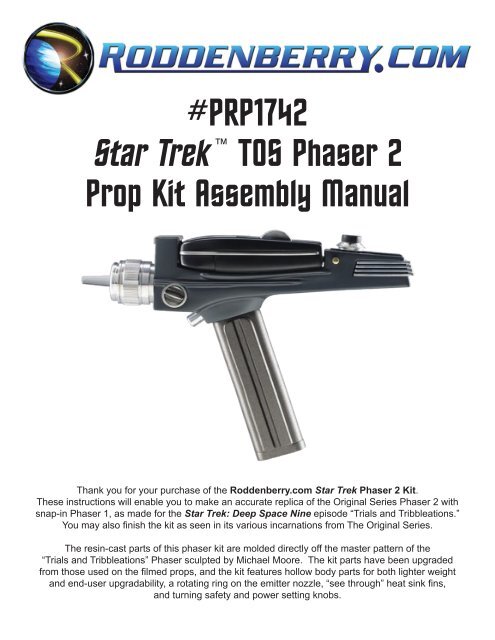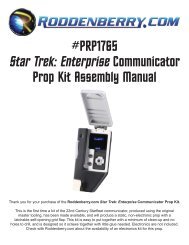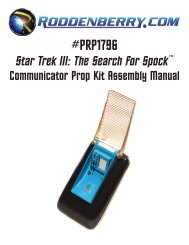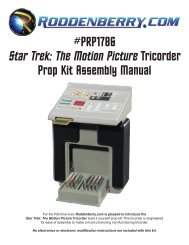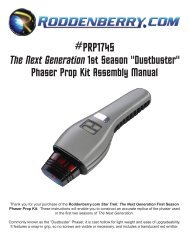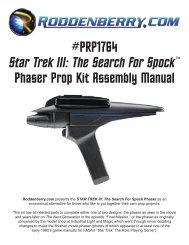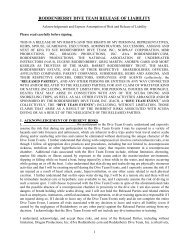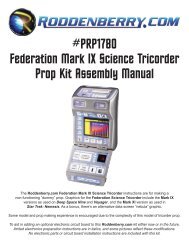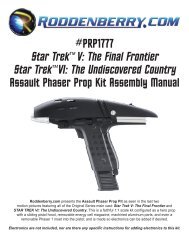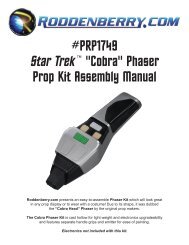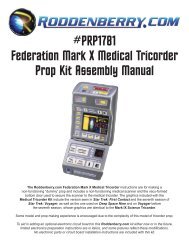STAR TREK: TOS PhASER 2 PROP KiT ... - Roddenberry.com
STAR TREK: TOS PhASER 2 PROP KiT ... - Roddenberry.com
STAR TREK: TOS PhASER 2 PROP KiT ... - Roddenberry.com
You also want an ePaper? Increase the reach of your titles
YUMPU automatically turns print PDFs into web optimized ePapers that Google loves.
#PRP1742<br />
Star Trek <br />
<strong>TOS</strong> Phaser 2<br />
Prop Kit Assembly Manual<br />
Thank you for your purchase of the <strong>Roddenberry</strong>.<strong>com</strong> Star Trek Phaser 2 Kit.<br />
These instructions will enable you to make an accurate replica of the Original Series Phaser 2 with<br />
snap-in Phaser 1, as made for the Star Trek: Deep Space Nine episode “Trials and Tribbleations.”<br />
You may also finish the kit as seen in its various incarnations from The Original Series.<br />
The resin-cast parts of this phaser kit are molded directly off the master pattern of the<br />
“Trials and Tribbleations” Phaser sculpted by Michael Moore. The kit parts have been upgraded<br />
from those used on the filmed props, and the kit features hollow body parts for both lighter weight<br />
and end-user upgradability, a rotating ring on the emitter nozzle, “see through” heat sink fins,<br />
and turning safety and power setting knobs.
2<br />
#PRP1742 - <strong>STAR</strong> <strong>TREK</strong>: <strong>TOS</strong> Ph A S E R 2 PR O P <strong>KiT</strong> AS S E m b l y mA n u A l<br />
BASIC LAYOUT AND INVENTORY
#PRP1742 - <strong>STAR</strong> <strong>TREK</strong>: <strong>TOS</strong> Ph A S E R 2 PR O P <strong>KiT</strong> AS S E m b l y mA n u A l 3<br />
NOTES ON MAKINg A <strong>TOS</strong> FIRST SEASON ''BLACK AND WhITE'' <strong>PhASER</strong>:<br />
Read all of the instructions first. If you wish to make a <strong>TOS</strong> First Season “Black and White” Phaser, then<br />
make the following modifications as you assemble your kit....<br />
Paints needed:<br />
Semi-Flat or Gloss Black spray paint (Phaser 1 and Phaser 2 Body)<br />
Gloss White or Pearlescent White (Handgrip)<br />
Parts not included:<br />
7/16” or 1/2” diameter x 1/2” length polished aluminum rod<br />
Scribed styrene sheet (Evergreen brand hobby plastic)<br />
Phaser 1 Modifications:<br />
Take the aspirator grill and bend it the other way -- the smooth side is out. Glue this with epoxy to the<br />
body, do not fill in the seams. Leave off the clear plex targeting lens for now and glue this on with the<br />
black vinyl underneath like for the standard Phaser 1 after painting.<br />
Glue on the side rails (the adjustment wheel can be installed later, or masked before painting) and the<br />
front before painting, then sand flush with the surface so it all appears as one piece, putty and sand<br />
smooth.<br />
Fill in and sand the power meter hole.<br />
Paint semi-gloss or gloss black, including the side rails and the aspirator grill area.<br />
After curing, glue on the clear targeting lens, and add the emitter tube and trigger button.<br />
The power meter graphics consists of cutting out numbers 1 and 10 in white squares and affixing them<br />
in place at either end of the surface where the plastic meter would go. The half-round meter is not used,<br />
and the graphic numbers are exposed.<br />
The rhinestone is not used with the B/W phaser.<br />
Phaser 2 Modifications:<br />
The power adjustment knob is a plain polished aluminum rod sticking out of the body, approximately<br />
7/16” to 1/2” in diameter and about 3/16” to 1/4” exposed. This can also be ringed by a finishing washer<br />
available at hardware stores if you want. Neither part is included; you’ll need to make those yourself.<br />
The metal heat sink may still be used -- it is painted the body color -- or you may bondo in the heat sink<br />
cavity on the body and either scribe in lines simulating the heat sink detail or use scribed Evergreen brand<br />
styrene hobby plastic in its place.<br />
The body is painted a semi-gloss or gloss black (using the same paint as on your Phaser 1), and the<br />
handgrip is gloss white...or if you can find it, a pearlescent white.<br />
All else is the same -- the release rod, side safety knob, top metal cover, lens window, trigger, and emitter<br />
nozzle are unchanged.<br />
Good luck with your kit!
4<br />
#PRP1742 - <strong>STAR</strong> <strong>TREK</strong>: <strong>TOS</strong> Ph A S E R 2 PR O P <strong>KiT</strong> AS S E m b l y mA n u A l<br />
PARTS LIST FOR <strong>PhASER</strong> 1:<br />
1 Upper Body<br />
1 Front<br />
1 Bottom Cover<br />
1 Aspirator Grill<br />
1 Clear Plex Targeting Lens<br />
1 Black Vinyl Strip<br />
1 Adjustment Wheel<br />
1 Power Meter with power level graphic<br />
1 Emitter<br />
1 Trigger Button<br />
1 Left Side Rail<br />
1 Right Side Rail<br />
1 Blue Rhinestone<br />
1 Rhinestone Mount<br />
1 4-40 x 3/8” Screw<br />
1 4-40 x 1/2” Screw<br />
1 Grommet Insert<br />
1 180 grit sandpaper<br />
1 320 grit sandpaper<br />
1 “Scotchbrite” pad<br />
TOOLS AND SUPPLIES NEEDED:<br />
All of these can be found in your local<br />
hardware store...<br />
Epoxy glue -- 5 minute curing<br />
Fine sandpaper -- 400 to 600 grit<br />
Small jeweler’s file (flat or half-round)<br />
Automotive spot putty<br />
Hobby knife (X-Acto brand or similar)<br />
Small brass wire brush (resembles a<br />
large toothbrush)<br />
Hand drill with 1/8” drill bit<br />
Some sort of hand saw (fine hobby saw or<br />
hacksaw)<br />
Cyanoacrylate glue (medium “gap-filling”<br />
type re<strong>com</strong>mended)<br />
Masking tape<br />
Toothpicks<br />
SPRAY PAINTS:<br />
Spray primer (sandable scratch-filler type)<br />
Krylon “Shadow Gray” (for Trials and Tribbleations)<br />
Zynolyte Dark Gray Primer (for <strong>TOS</strong>)<br />
Krylon Matte Finish or Testors Dullcote<br />
(if you’re using a primer as the color coat)<br />
Semi-Flat or Gloss Black (for <strong>TOS</strong>)<br />
OPTIONAL TOOLS AND SUPPLES:<br />
Automotive body filler (Bondo brand or similar)<br />
Dremel brand moto tool or similar<br />
Metal polish (Simichrome or other)<br />
Velcro<br />
Wash your resin parts with soap and water to remove any lingering traces of mold<br />
release before you begin.
#PRP1742 - <strong>STAR</strong> <strong>TREK</strong>: <strong>TOS</strong> Ph A S E R 2 PR O P <strong>KiT</strong> AS S E m b l y mA n u A l 5<br />
Step 1: Start by cutting off the sprues (if present) with your saw and<br />
sanding the flashing and mold lines from the three main resin body<br />
parts. Then fill any objectionable scratches and holes with the spot<br />
putty. While the resin parts were pressure-cast to minimize bubbles<br />
and voids, there may still be small bubbles present in the castings that<br />
will need to be filled and sanded.
6<br />
#PRP1742 - <strong>STAR</strong> <strong>TREK</strong>: <strong>TOS</strong> Ph A S E R 2 PR O P <strong>KiT</strong> AS S E m b l y mA n u A l<br />
Step 2: While the putty is drying, sand the edges and mold lines off of the cast metal parts. As you work,<br />
continually check the fit of your parts and sand or file away any resin or metal that interferes with proper fit<br />
and function.<br />
Step 3: The aspirator grill finish is achieved by wire brushing the top surface with your small brass brush.<br />
Brush with the diamond pattern in both directions to give it the desired finish.<br />
Step 4: Sand the outer edges of the two side rails until smooth (down to 400-600 grit). Be careful, as they<br />
are easily bent. Rubbing them with the Scotchbrite pad will give the rails a nice brushed look, or they can<br />
be polished with metal polish.<br />
The rails and the aspirator grill can be bent slightly for a more even fit -- be careful not to over-bend.
#PRP1742 - <strong>STAR</strong> <strong>TREK</strong>: <strong>TOS</strong> Ph A S E R 2 PR O P <strong>KiT</strong> AS S E m b l y mA n u A l 7<br />
Step 5: Try the fit of the clear plex targeting lens and the aspirator grill, sand either or both parts until they<br />
fit. The targeting lens may not appear to be even to the surface of the body. You may add material to the<br />
low end or cut away material from the high end on the body until it looks good to you.<br />
Step 6: Drill a 1/8” hole into the end of the bottom cover, enough for the grommet insert to fit in. The<br />
grommet may be installed before or after painting.<br />
Step 7: Clean the hole in the front where the emitter tube fits in.
8<br />
#PRP1742 - <strong>STAR</strong> <strong>TREK</strong>: <strong>TOS</strong> Ph A S E R 2 PR O P <strong>KiT</strong> AS S E m b l y mA n u A l<br />
Step 8: Install the adjustment wheel onto the left side rail using the 4-40 x 3/8” screw. You will want this<br />
slightly loose so the wheel spins freely. Fit this assembly onto the phaser, and file away the slot in the body<br />
if it interferes with the smooth spinning of the wheel (see next photo below). Be sure to file at an angle<br />
to avoid filing away any of the visible slot. Try the fit again to be sure it works; once satisfied as to the<br />
function, glue the end of the screw with cyanoacrylate glue so it can’t work its way loose.<br />
Step 9: Once again, continue to test fit your parts!
#PRP1742 - <strong>STAR</strong> <strong>TREK</strong>: <strong>TOS</strong> Ph A S E R 2 PR O P <strong>KiT</strong> AS S E m b l y mA n u A l 9<br />
Step 10: Make yourself some small hangers so you can hang your resin parts for painting. It may help to<br />
slightly roughen up your surfaces with 320-400 grit sandpaper before you spray your first coat of primer.<br />
You may mask off the areas that you’ll be gluing parts to before you paint, as glued parts do not adhere<br />
well to painted surfaces.<br />
After your first coat of primer dries, check the finish of the surfaces. The primer coat may reveal scratches<br />
and other flaws that were not visible to you before, use the spot putty and sand those spots. Primer again<br />
and repeat if needed -- it may take several putty, sanding, and primer steps before you get a surface that<br />
you’re pleased with.<br />
When the final primer coat is dried enough, spray on your first coat of color. ”Trials and Tribbleations”<br />
phasers were painted Krylon Shadow Gray, or you have the choice of using Zynolyte Dark Gray Primer or<br />
similar, or a semi-flat or gloss black color coat if you want to paint a color used on <strong>TOS</strong>.<br />
If you’re using a primer as your color, give your phaser a final coat of clear Krylon Matte Finish, Testor’s<br />
Dullcote, or another brand of clear finish.<br />
You may if you wish wet sand in between coats with 600 grit or finer sandpaper for an ultimate smooth<br />
finish.<br />
Allow your painted body parts to dry and cure before you handle them again, allow several hours or<br />
overnight before you begin final assembly. If you’ve masked any areas before painting, remove the<br />
masking tape carefully so you don’t lift your freshly painted surfaces. You may need to score the tape<br />
edges with a hobby knife before lifting the tape off.
10<br />
#PRP1742 - <strong>STAR</strong> <strong>TREK</strong>: <strong>TOS</strong> Ph A S E R 2 PR O P <strong>KiT</strong> AS S E m b l y mA n u A l<br />
Step 11: Before gluing your parts on, roughen up any surfaces you’re gluing together. This is also<br />
necessary to remove paint from your joints since resin glues better to resin and metal than it does to paint.<br />
Be very careful you do not damage any visible surfaces. While gluing, try to avoid handling the phaser any<br />
more than necessary to keep glue fingerprints off. Allow sufficient cure time in between installing parts.<br />
Step 12: Start by gluing the side rails to the upper body, one at a time. You can wipe away excess<br />
“outside” glue while it’s still wet, or you can leave it alone without touching it and pick away at the glue with<br />
toothpicks when it starts to cure but before full hardness -- there is a small window of opportunity when you<br />
can do this without damaging finished surfaces. When the glue is soft without being sticky and stringy is<br />
best for this; it will get progressively harder to remove glue this way the more it is curing.
#PRP1742 - <strong>STAR</strong> <strong>TREK</strong>: <strong>TOS</strong> Ph A S E R 2 PR O P <strong>KiT</strong> AS S E m b l y mA n u A l 11<br />
Step 13: You may use your own preference for the order in which the rest of the parts assemble. Glue<br />
the front on using cyanoacrylate on the resin-to-resin joint, or epoxy if you want to have the convenience<br />
of moving the parts slightly for final positioning. Look at the front of the phaser and make sure you’re<br />
putting it on straight and even; once in place it will be hard to correct a visual mistake. Spread epoxy inside<br />
where the front butts up on the rails. Install the emitter either before or after gluing the front, it sticks out<br />
approximately 1/16 of an inch (see photos on the bottom). Spread epoxy around the emitter on the inside;<br />
it is not necessary to put glue in before pushing the emitter in the hole.<br />
Glue on the aspirator grill with epoxy. You may spread glue inside the body for greater strength; this also<br />
applies for all the other parts.
12<br />
#PRP1742 - <strong>STAR</strong> <strong>TREK</strong>: <strong>TOS</strong> Ph A S E R 2 PR O P <strong>KiT</strong> AS S E m b l y mA n u A l<br />
Step 14: Put the black vinyl tape on one surface of the clear plex targeting lens, this helps to keep from<br />
seeing into the interior of the phaser. Glue the taped targeting lens onto the phaser, tape side down. You<br />
may want to add a piece of support plastic at the joint of the targeting lens and aspirator grill, or at least add<br />
extra glue there inside the phaser.<br />
Step 15: Epoxy the power meter onto the graphic. You may use your choice of power number ranges;<br />
there is enough length on the graphic so if you make a mistake with your gluing, you can peel off the<br />
graphic and try again. When the glue has been curing for a few minutes, cut away the excess graphic with<br />
your hobby knife before it achieves full cured hardness.<br />
The “Trials and Tribbleations” Phaser 1 had a blue rhinestone in between the meter and adjustment wheel.<br />
Many of the <strong>TOS</strong> phasers didn’t have the rhinestone or used a red one, so its installation is purely a matter<br />
of preference as well as what color you use (he Blue “Trials and Tribbleations” rhinestone is the only one<br />
supplied).
#PRP1742 - <strong>STAR</strong> <strong>TREK</strong>: <strong>TOS</strong> Ph A S E R 2 PR O P <strong>KiT</strong> AS S E m b l y mA n u A l 13<br />
Step 16: To install the rhinestone, scrape away a very small patch of paint where the rhinestone goes.<br />
There is no specific place imprinted on the casting for this; you’ll have to eyeball its placement. Sand<br />
the metal rhinestone mount until flat. Place a tiny drop of epoxy on this patch then very carefully put the<br />
rhinestone mount in place, using tweezers if needed. The rhinestone may be glued onto the plate either<br />
before or after it goes on the phaser.<br />
Step 17: Epoxy on the power meter assembly; make sure it fits in the hole before you glue it.<br />
Step 18: Glue the trigger button onto the bottom cover.
14<br />
#PRP1742 - <strong>STAR</strong> <strong>TREK</strong>: <strong>TOS</strong> Ph A S E R 2 PR O P <strong>KiT</strong> AS S E m b l y mA n u A l<br />
Step 19: Secure the bottom cover with the 4-40 x 1/2” screw. If you wish, you may affix a piece of Velcro<br />
to the cover to carry your phaser with a costume.<br />
Enjoy your new Phaser 1 or insert it in place to be part of your Phaser 2!<br />
Phaser 2 assembly instructions follow...
#PRP1742 - <strong>STAR</strong> <strong>TREK</strong>: <strong>TOS</strong> Ph A S E R 2 PR O P <strong>KiT</strong> AS S E m b l y mA n u A l 15<br />
PARTS LIST FOR <strong>PhASER</strong> 2:<br />
1 Phaser 1 Instructions<br />
and Parts<br />
1 Main Body<br />
1 Handgrip<br />
1 Emitter Nozzle with<br />
turning ring assembled,<br />
and acrylic emitter tip<br />
1 Clear Lens Window<br />
1 Set of 4 Heat Sink Fins<br />
1 Top Lens Cover<br />
1 Side Safety Knob with<br />
Sleeve (includes 4-40 nut<br />
and washer)<br />
1 Power Setting Knob<br />
(includes knob cap, knob,<br />
brass bushing sleeve, and<br />
securing cap)<br />
1 Trigger<br />
1 Bullet Catch<br />
1 Phaser 1 Release Rod<br />
(nonfunctional)<br />
1 Saddle Plate template and plastic strip<br />
1 #6 x 1” Dry Wall Screw and Washer<br />
1 180 grit Sandpaper<br />
1 320 Grip Sandpaper<br />
1 “Scotchbrite” Pad<br />
PAINTS NEEDED:<br />
Black brush-on paint with small brush,<br />
or black spray paint<br />
Spray primer (sandable scratch-filler type)<br />
Krylon “Smoke Gray” spray paint<br />
(for “Trials and Tribbleations”)<br />
OPTIONAL PAINTS FOR <strong>TOS</strong> <strong>PhASER</strong>S:<br />
Body:<br />
Krylon All-Purpose Grey primer<br />
(also an alternative to Smoke Gray)<br />
Krylon Matte Finish or other clear paint<br />
(necessary if using a primer as the final color)<br />
Krylon Slate Blue or other blue-grey paint<br />
Handgrip:<br />
Semi-flat or Gloss Black<br />
Dark Bronze or Anthracite Grey<br />
TOOLS AND SUPPLIES NEEDED:<br />
All of these can be found in your local hardware<br />
store...<br />
Hobby knife (X-Acto brand or similar)<br />
Fine sandpaper (400 to 600 grit)<br />
Hand drill with 1/8”, 5/32”, and 5/16” drill bits<br />
Small jeweler’s files (flat and round)<br />
Automotive spot putty<br />
Auto body filler (Bondo brand or similar)<br />
Epoxy glue (5 minute type)<br />
Cyanoacrylate glue (Medium “gap-filling” type<br />
re<strong>com</strong>mended)<br />
Metal polish (Simichrome or similar)<br />
Philips screwdriver (#2)<br />
A mild solvent such as naphtha or alcohol<br />
OPTIONAL TOOLS:<br />
Dremel brand moto tool or similar<br />
Masking tape
16<br />
#PRP1742 - <strong>STAR</strong> <strong>TREK</strong>: <strong>TOS</strong> Ph A S E R 2 PR O P <strong>KiT</strong> AS S E m b l y mA n u A l<br />
Note: These instructions assume you have <strong>com</strong>pleted the included Phaser 1 kit -- if not, you may want to<br />
build that first. Certain instructions are repeated here; depending on which version of the phaser you are<br />
making, the order of work can be changed.<br />
Instructions for making certain parts functional are in italics.<br />
Wash your resin parts with soap and water to remove any residual mold release.<br />
Test fit your parts as you are working on the phaser.<br />
Step 20: Start by removing any residual sprues and mold flash and lines from all parts, and putty or bondo<br />
all objectionable scratches, mold lines, dips, or holes. While the resin parts were pressure-cast, there<br />
might still be small bubbles present in the castings that need to be filled in. Most such bubbles will be<br />
concentrated on the bottom front edge of the main body below where the emitter nozzle goes.<br />
Step 21: The cast metal parts may be sanded smoother and rubbed with the Scotchbrite pad for a brushed<br />
finish, or can be sanded to 600 grit or finer and polished with the metal polish.<br />
Sand the metal front top cover smooth, and scotchbrite the surface with the grain going side to side.
#PRP1742 - <strong>STAR</strong> <strong>TREK</strong>: <strong>TOS</strong> Ph A S E R 2 PR O P <strong>KiT</strong> AS S E m b l y mA n u A l 17<br />
Step 22: Test fit the acrylic emitter tip into the machined emitter nozzle. If it is too tight, it may be sanded<br />
until it is as tight or as loose as you want. Epoxy the tip in place -- where the taper begins on the acrylic tip<br />
is where it starts to be visible in the emitter hole.<br />
Step 23: Drill a 5/32” hole in the side of the main body where the release rod goes. The amount it sticks<br />
out of the finished prop is entirely up to you. 1/8” to 1/4” is good, but make sure the rod won’t interfere with<br />
inserting the bullet catch.<br />
The main body is cast with a 1/4” hole for the power setting knob. If you are gluing the knob permanently<br />
in place without it having the capacity to turn, leave this hole alone and cut off the knob axle short enough<br />
for the knob to bottom out.
18<br />
#PRP1742 - <strong>STAR</strong> <strong>TREK</strong>: <strong>TOS</strong> Ph A S E R 2 PR O P <strong>KiT</strong> AS S E m b l y mA n u A l<br />
Step 24: For anyone who wants a functioning knob, enlarge and deepen the top knob hole using a 5/16”<br />
drill bit, enough for the axle and brass bushing sleeve to fit in with the securing cap at the end...it must<br />
have clearance for turning. Be sure you drill straight, as any angle will cause the knob to sit angled to the<br />
surface.<br />
Step 25: Drill a 5/16” hole in the body where the side safety knob goes, in the middle of the cast-in<br />
depression. Enlarge the metal safety knob sleeve hole with a knife or a 1/8” drill bit for the knob screw to<br />
go in and turn freely.<br />
Step 26: Sand the circumference of the safety knob if it doesn’t fit into the sleeve. Secure with the 4-40 nut<br />
and washer, leaving it loose so the knob can turn without interference. Very sparingly glue the nut to the<br />
screw with cyanoacrylate or epoxy; it only has to stay in place on the screw, and will rotate with the knob<br />
without it <strong>com</strong>ing loose after gluing the knob assembly onto the phaser.
#PRP1742 - <strong>STAR</strong> <strong>TREK</strong>: <strong>TOS</strong> Ph A S E R 2 PR O P <strong>KiT</strong> AS S E m b l y mA n u A l 19<br />
Step 27: Drill a 5/32” or 1/8” hole into the upper end of the handgrip, deep enough for the drywall screw.<br />
For a “Trials and Tribbleations” phaser, the body and handgrip are painted the same color, so you can<br />
attach the grip on the body at this point if you want to, using the drywall screw and washer and gluing the<br />
tightened joint with cyanoacrylate inside the body so it can’t move on you. Otherwise, leave it separate to<br />
make it easier to paint each part two different colors.<br />
Step 28: The heat sink fin parts are numbered 1 through 4, with #4 being the bottom [tabs stick up],<br />
followed by #3, then #2 and finally #1 with the smooth side up. Sand the edges of the fins until smooth and<br />
test fit the unglued heat sink in the phaser. It may be easier to not have the four fins tacked together before<br />
final assembly. You may need to sand or file the front and/or rear ends of the fins if the angles do not<br />
visually line up evenly. You may also wish to paint the visible portions of the tabs in your chosen phaser<br />
body color or black.
20<br />
#PRP1742 - <strong>STAR</strong> <strong>TREK</strong>: <strong>TOS</strong> Ph A S E R 2 PR O P <strong>KiT</strong> AS S E m b l y mA n u A l<br />
Step 29: Make the Phaser 2 body saddle plate using the supplied plastic strip and template You may want<br />
to make a copy of the template before starting, in case you make a mistake with the plastic strip.<br />
Attach the paper template with tape; or if you have it, use double-sided tape or a low tack spray glue such<br />
as 3M brand Spray 77. Cut out your template using a hobby knife; you can score and snap the excess<br />
plastic away. Drill out the hole and file or Dremel the oval shape.<br />
Naphtha or denatured alcohol is good for cleaning up residual glue -- do not use lacquer thinner, acetone,<br />
or MEK on styrene or acrylic parts since they will chemically melt on you and ruin the parts.<br />
Step 30: Test fit the saddle and sand away more if needed until you’re satisfied with the fit. Also snap in<br />
your <strong>com</strong>pleted Phaser 1 to make sure the oval hole has enough clearance for the Phaser 1 trigger button.<br />
Test fit the bullet catch in the pre-drilled hole -- if the Phaser 1 grommet doesn’t line up properly (either the<br />
Phaser 1 is too high off the Phaser 2 body or hits bottom without it catching), you’ll need to Dremel the hole<br />
bigger in one direction or the other until the Phaser 1 is seated in the right place. You may also have to<br />
counter bore the hole deeper to make the catch sit in more if you have trouble pushing the Phaser 1 into<br />
place.<br />
At this point, you have the option of painting your resin parts and saddle plate separately, or you can screw<br />
the handgrip on and glue it in place permanently, then glue in the trigger, and glue on the saddle plate and<br />
bondo and smooth the seams; but you will then have to mask the trigger and one or the other resin parts<br />
for a two-tone finish.
#PRP1742 - <strong>STAR</strong> <strong>TREK</strong>: <strong>TOS</strong> Ph A S E R 2 PR O P <strong>KiT</strong> AS S E m b l y mA n u A l 21<br />
Step 31: When your resin parts and cover plate are fully prepared, spray on your first coat of primer.<br />
After your first coat of primer dries, check the finish of the surfaces. The primer coat may reveal scratches<br />
and other flaws that were not visible to you before; use the spot putty and sand those spots. Primer again<br />
and repeat if needed -- it may take several putty, sanding, and primer steps before you get a surface that<br />
you’re pleased with.<br />
When the final primer coat is dried enough, spray on your first coat of color. The “Trials and Tribbleations”<br />
Phaser 2 body and handgrip were painted Krylon Smoke Gray, or you have the choice of using any of the<br />
colors suggested in the paint list for <strong>TOS</strong> phasers.<br />
If you’re using a primer as your final color, give your phaser a coat of clear Krylon Matte Finish, Testors<br />
Dullcote, or another brand of clear finish over the primer.<br />
You may wet sand in between coats of paint with 600 or finer grit sandpaper for an ultimate smooth finish.<br />
Allow your painted body parts to dry and cure before you handle them again, allow several hours or<br />
overnight before you begin final assembly. If you’ve masked any areas before painting, remove the<br />
masking tape carefully so you don’t lift your freshly painted surfaces. You may need to score the tape<br />
edges with a knife before lifting the tape off.<br />
Any areas on the body that will have parts glued to it will need to have the paint scraped away. Be very<br />
careful to not damage any paint surfaces that will be visible. Allow the epoxy to set and harden on each<br />
part before going on to the next part to be glued.
22<br />
#PRP1742 - <strong>STAR</strong> <strong>TREK</strong>: <strong>TOS</strong> Ph A S E R 2 PR O P <strong>KiT</strong> AS S E m b l y mA n u A l<br />
Step 32: If you haven’t done this before now, screw on and epoxy or cyano glue the handgrip to the body.<br />
The screw will hold the grip in place, the glue assures the grip won’t flex or twist on you.<br />
Step 33: The trigger goes in next from the inside. Epoxy glue this from the inside so you can’t accidentally<br />
push this in when playing with your phaser.
#PRP1742 - <strong>STAR</strong> <strong>TREK</strong>: <strong>TOS</strong> Ph A S E R 2 PR O P <strong>KiT</strong> AS S E m b l y mA n u A l 23<br />
Step 34: The body saddle plate glues on next. The seams are okay to be visible since the Phaser 1 covers<br />
this whole section of the Phaser 2. You can hide the seams if you want to with bondo; it’s just a lot more<br />
work to do this after painting than before.<br />
Step 35: The bullet catch is installed by spreading a small amount of epoxy in the hole then inserting<br />
the catch, making sure you don’t get any glue inside the catch where the spring is. Test press the catch<br />
frequently to be sure it still functions. Only a little glue is necessary.<br />
Step 36: Before assembling the power setting knob, make the graduated numbers stand out by drawing on<br />
the numbers and lines with a black felt pen, then wipe the excess away with naphtha or alcohol. Paint the<br />
knob cap with brush-on or spray black paint, then glue this onto the top of the knob.
24<br />
#PRP1742 - <strong>STAR</strong> <strong>TREK</strong>: <strong>TOS</strong> Ph A S E R 2 PR O P <strong>KiT</strong> AS S E m b l y mA n u A l<br />
Step 37: For a nonfunctioning knob, cut off the stem so the knob is short enough to fit in the existing hole.<br />
And after painting and assembling the knob cap to the knob, epoxy in place.<br />
For a functioning knob assembly: assemble the lower knob by inserting the brass bushing sleeve with the<br />
wide part up (see photo above). Make sure this sleeve turns freely on the axle, sand away at the axle until<br />
it is no longer tight if necessary.<br />
Step 38: Insert the securing cap and (very sparingly!) glue into the hole with cyano. The brass sleeve<br />
should still turn freely and should have a little up/down play, the securing cap will turn with the rest of the<br />
knob.<br />
Step 39: Glue on the knob with epoxy by inserting the knob into the hole part of the way, then apply a little<br />
epoxy to the brass sleeve, then push in the rest of the way. With luck, you didn’t glue anything other than<br />
the sleeve and you have a working power setting knob.
#PRP1742 - <strong>STAR</strong> <strong>TREK</strong>: <strong>TOS</strong> Ph A S E R 2 PR O P <strong>KiT</strong> AS S E m b l y mA n u A l 25<br />
Step 40: Press the release rod into the side. This may be glued or not depending on how loose the fit is.<br />
Step 41: Epoxy glue the heat sink to the back of the body. You may need to tweak the individual fins for<br />
proper spacing before the glue sets.<br />
Step 42: Epoxy glue the side safety knob assembly into place without getting epoxy onto the turning nut<br />
and screw.
26<br />
#PRP1742 - <strong>STAR</strong> <strong>TREK</strong>: <strong>TOS</strong> Ph A S E R 2 PR O P <strong>KiT</strong> AS S E m b l y mA n u A l<br />
Step 43: Test fit the clear lens window; if it doesn’t go in, sand the edges until it fits. Epoxy the metal top<br />
lens cover in place, both on top and underneath.<br />
Step 44: Glue on your emitter nozzle assembly.
IMPORTANT NOTES:<br />
#PRP1742 - <strong>STAR</strong> <strong>TREK</strong>: <strong>TOS</strong> Ph A S E R 2 PR O P <strong>KiT</strong> AS S E m b l y mA n u A l 27<br />
Step 45: Snap on your Phaser 1 and admire your handiwork because you’re done!<br />
The reproduction of the <strong>Roddenberry</strong>.<strong>com</strong> Star Trek <strong>TOS</strong> Phaser 2 Kit or any of its parts by any means<br />
known or yet to be invented (including molding and recasting, reverse-engineering, or 3D scanning/SLA<br />
printing) is expressly prohibited by United States and international copyright and product protection laws.<br />
Copyright © 2009 <strong>Roddenberry</strong> Productions.<br />
Star Trek and related marks and logos are Trademarks of CBS Studios Inc. All rights reserved.


